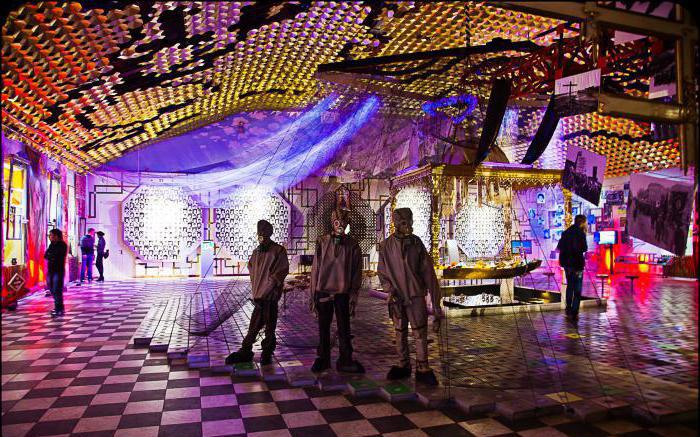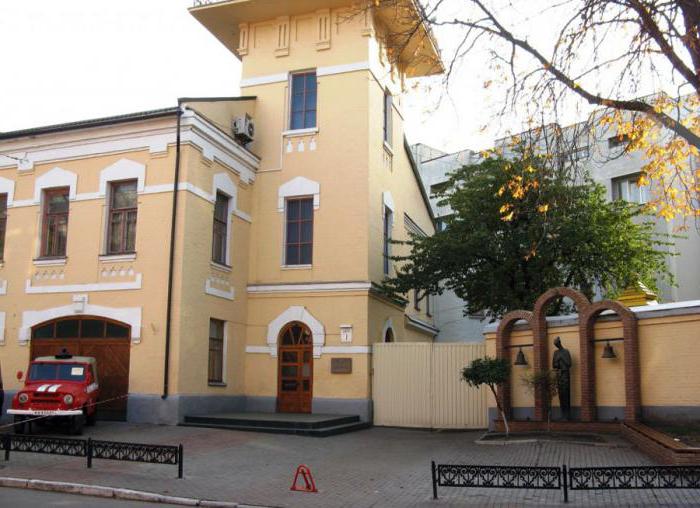Chernobyl became known after the terrible disaster at the Chernobyl nuclear power plant. The older generation remembers well the day when the alarming message of the President of the USSR M.S. Gorbachev was heard on television that on April 26, only 110 km from Kiev, the most serious man-made disaster in nuclear energy occurred, which subsequently claimed the lives of thousands of people and became a source of radioactive contamination of a vast territory in 200 thousand square meters km The consequences of the tragedy are still felt not only in Ukraine, but also in the adjacent territories of Russia and Belarus.
Chernobyl Museum in Kiev
So that mankind would not forget about the dangers that nuclear energy might pose, the Chernobyl Museum was opened in 1992. Kiev allocated for it the building of a fire station with an area of 1100 square meters. m. Currently, the museum’s exposition has more than 7,000 copies telling about the events of that night when the accident and the consequences of the disaster. A strong impression on visitors is made by the road leading to the halls of the Museum. On it are attached to the ceiling tablets with the names of villages and towns that were abandoned after the tragedy. In connection with the accident, 76 villages and towns disappeared from the territory of Ukraine.

On the road lies an apple tree, which was uprooted. This is a biblical symbol of life, the knowledge of evil and good. Red apples scattered along the road symbolize wealth and joy. They seem to say that the lives of many thousands of people changed in an instant. People left their native places, and fields and gardens were overgrown with weeds, thousands of hectares of land were ruined. The road to the museum halls symbolizes the road to the Chernobyl nuclear power plant.
Museum expositions
The Chernobyl Museum (Kiev) created expositions that make it possible to realize the consequences of the destructive action of an atom that has gone out of control. The road leads visitors to the Temple in the center of the hall. Here stands the iconostasis, individual elements of which were brought from the Ascension Church, which fell into the exclusion zone. Not far from the iconostasis there is a boat symbolizing Noah's ark, candles are constantly burning here, as a symbol of maternal and childish happiness destroyed by radiation. There are always many toys in the ark that children leave when they visit the museum. The barbed wire with an orange trefoil, a symbol of increased radiation, entangles the entrance to the iconostasis.

In the center of the hall, the acting diorama was recreated, which shows how Chernobyl was before the accident, the moment when the disaster at the Chernobyl nuclear power plant occurred, as well as what the station currently looks like. In front of visitors, there is a moment of explosion and destruction of the station, after which a sarcophagus appears above it.
The ceiling of the hall is made in the form of a map of the world. The lights of all nuclear power plants on all continents blink on it. The floor of the hall looks like a slab for biological protection, which should be on the main reactor.
Photo and video materials about the Chernobyl tragedy
The National Museum of Chernobyl presented not only the exposure of the nuclear power plant. Here you can see previously classified videos about how several explosions occurred, during which two workers of the station died right away, how the fire started, how people left the city, and how the fire was extinguished at the Chernobyl nuclear power plant. Among these materials you can see photos of the cemetery of military equipment that took part in the liquidation of the accident.
The museum exhibits include documents, photographs, and maps labeled “Secret.” In addition, the things of the liquidators of the accident, valuable icons and handicrafts exported from the exclusion zone, samples of protective suits in which the military and firemen were engaged in extinguishing fire on the territory of the station were exhibited there. Given the concept and nature of the presentation of the material, the Chernobyl Museum (Kiev) has no analogues in the world.
Evacuation of people
Among the photographs and videos you can find documentary footage of the evacuation of people who did not know the scale of the incident and expected to return to the city in 3 days. None of them could imagine that they would no longer see their hometown, and in a new place they would have to start life anew.
The evacuation of people began on April 27, when no one else in the world knew about the tragedy. 1225 buses arrived in the city of Pripyat, where the Chernobyl workers lived. Two diesel trains were delivered to the railway station. More than 50 thousand people left the city in three hours. Buses brought people to different areas of Kiev. One of these places was Kontraktova Square, next to which a museum is open. Until the end of 1986, a 30-kilometer exclusion zone was created near Chernobyl. The whole population and more than 60 thousand heads of farm animals were taken out from there.
Fire extinguishing at the station
After the accident, none of the scientists could predict the development of events. Specialists were afraid of a second explosion of other objects, so it was decided to throw the blazing reactor with boron sand and other materials that extinguished the nuclear reaction. For this, a full-fledged aviation division was involved in the withdrawal of troops from Afghanistan.
In order to dump the load exactly into the reactor, it was necessary to fly at a low height above the reactor, the combustion temperature of which exceeded 1000 ° C. Because of this, several helicopters fell to the ground, and by a lucky chance none of the pilots died. Only one helicopter fell into a burning reactor with the crew, but this fact was kept secret for many years.
How to clean the roof
The most tragic pages of the liquidation of the accident are connected with cleaning the roof of pieces of graphite that flew out of the reactor. According to experts, it was about 300 tons. The first to join the work were the employees of the nuclear power plant and the fire department of the city. Later they were replaced by soldiers of military service. Video cameras were installed on the roof, according to which the soldiers were shown which pieces should be removed first.
They were all warned of danger, so only volunteers were sent to the roof. To protect the soldiers from radiation, lead armor was made for them, covering the torso, back of the head, and other vital organs. The radiation dose was so high that they were on the roof for no more than a minute, after which they were taken to a clean area. Officers testified that the guys were awarded 1,000 rubles each and were immediately fired.
Construction of the sarcophagus over Chernobyl
To reduce the background radiation, it was decided to build a sarcophagus over the exploding reactor. All work was carried out by specialists with experience working with radiation sources from specially equipped shelters.
For this, devices with remote control were used. Protective metal structures were assembled in clean places and delivered to the place by heavy-duty cranes. People who went to the most dangerous places were provided with special protection, so none of them received a radiation dose exceeding the permissible value.
The construction of the sarcophagus was carried out according to a project developed by Leningrad scientists. To ensure the front of work, near the Chernobyl nuclear power plant 4 plants of reinforced concrete structures were built. Transport with special clearance could call into the station, so the cars brought the cargo to a specific place, after which it was reloaded on vehicles operating in the accident zone. All these events are described in the museum.
Memory Book at the Chernobyl Museum
Chernobyl NPP is the tears and pain of Ukraine. The book of memory is dedicated to people who have accepted the challenge of an uncontrolled atom. About 5 thousand names are entered into it.
The memory book is an electronic search engine that every visitor has access to. It contains the names and photographs of all the liquidators of the accident, there is information about what dose of radiation each of them received, what work was performed in the disaster area. Photos of people who are no longer among the living are marked with a yellow and black circle. Some images are under the wing of a white angel. This is a photo of children who were born after the accident and are currently struggling with diseases caused by the effects of radiation.
The international importance of the museum
The Chernobyl Museum (Kiev) leaves no one indifferent. He is well known outside of Ukraine. Several times, museum workers staged exhibitions abroad. After that, numerous reviews and new exhibits began to arrive here.
Many foreign mass media respond to the philosophical orientation of the expositions. The museum was visited by more than 80 foreign delegations, as well as heads of state and government from many countries of the world. The UN Mission, headed by the Secretary General of this organization, the President of the OSCE, as well as the President of the European Commission, visited here. All of them noted that museum exhibits play an important role in the spiritual development of man.

Thanks to the work carried out by the museum, the US Congress initiated a program to improve the health of Chernobyl children. As part of the program, 5 Ukrainian-American health centers in the regions that were most affected by the accident were built in Ukraine. In order to identify thyroid diseases, more than 116 thousand children were examined. The Ukrainian-Cuban program "Children of Chernobyl" also operates, according to which about 18 thousand children with cancer, orthopedic and other diseases underwent rehabilitation in Cuba.
How to get to the Museum
Today, everyone can visit the Chernobyl Museum in Kiev. His address: per. Khoriva, 1. It is open from 10 a.m. to 6 p.m. every day except Sunday. Getting to him is easy. Trams 13, 14 and 19, as well as bus number 62 stop next to him. It is most convenient to get to it by metro. You need to go to the stop "Contract Area".
A visit to the museum gives an idea of what catastrophes can happen to humanity due to possible errors in nuclear energy, so not only students and schoolchildren, but also serious delegations come to the Chernobyl Museum (Kiev). Ticket price is considered symbolic. For schoolchildren and students, it is 5 UAH., For adults - 10 UAH. For servicing foreign delegations with a translator you need to pay 100 UAH. Entrance to the museum is free for emergency workers.